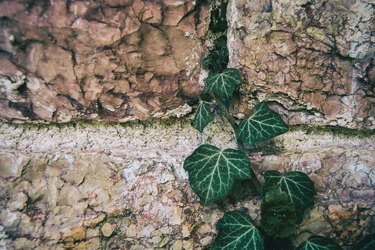
When you take care of ivy plants, you fill your home with lush vining foliage with large, beautifully shaped leaves. While there are many varieties of ivy, English ivy (Hedera helix, U.S. Department of Agriculture plant hardiness zones 4 through 9) is a popular option that grows indoors as a houseplant or outdoors on walls, fences and other structures. The care requirements are similar indoors or outdoors to keep the vining foliage beautiful and healthy.
It's important to note, however, that English ivy is on invasive plant lists for many areas, so growing it as a houseplant or outdoor container plant is the responsible choice instead of letting it overtake a native plant habitat in the landscape. Check with your local cooperative extension service for a recommendation of a non-invasive ivy species for your location.
Video of the Day
Video of the Day
Growing Conditions for Ivy Plants
Specific growing conditions can vary by cultivar, but English ivy and many other ivy types enjoy bright, indirect sunlight for optimal growth. Under low to moderate light conditions, your ivy will likely slow down its growth. If you have a variegated ivy cultivar, you might notice the foliage turning completely green under lower light.
For indoor ivy, choose a bright spot near a window that's not in direct sunlight. Temperatures between 50 and 70 degrees Fahrenheit are optimal. Ivy can handle temperatures 5 to 10 degrees cooler at night. Keep your potted ivy plants away from drafts or vents where the temperatures can fluctuate, and the air can dry out the plant.
Ivy Soil Requirements
For indoor ivy plants, choose a houseplant potting soil to supply nutrient-rich soil that drains well. Choose a container with drainage holes to keep the soil from holding too much water.
Outdoor ivy can grow on most soil types as long as it drains well. If the soil stays overly wet or has standing water, it can affect growth. The ideal soil pH for ivy is 5.5 to 6.5. A soil tester can tell you the current pH and help you decide if you need to amend the soil before planting ivy.
Watering Requirements for Ivy Plants
Ivy prefers soil that remains consistently moist without being overly wet. Too much moisture can cause root rot. Once established, outdoor ivy typically doesn't need supplemental watering unless you're in a drought period. When you first plant ivy outdoors, water it consistently to keep the soil evenly moist while it becomes established.
Indoor ivy needs consistent watering, but don't go overboard. It's better to let it go to the dry side than to overwater it. To check, press your finger into the potting soil, and if the top inch is dry, water the plant. If it's still moist, hold off on watering. Empty the saucer if water runs out of the drainage holes.
Add Humidity to Indoor Plants
Instead of adding lots of water to the soil, add it to the air to keep your indoor ivy happy. Humidity helps ivy plants thrive, and you can add it in a variety of ways, including misting the plant or adding a humidifier to the room. Another option is a humidity tray with pebbles and water in a saucer under your ivy plant. The pebbles keep the roots from sitting in the water.
Prune Your Ivy
Outdoor ivy can sometimes become leggy with thinner foliage production. Pruning the ivy can encourage denser growth when this happens. Prune those runners with pruning shears by a quarter of their length to improve growth. You might also need to prune ivy to remove vines from siding, fences or other areas where you don't want the growth. Ivy is typically a vigorous grower if left unpruned, so keeping it under control is important.
Your indoor ivy can also use pruning occasionally. Trimming long runners keeps the ivy plant bushy and full. Cut each stem below a leaf node when pruning.
Watch for Pests and Diseases
Indoor ivy usually doesn't have a lot of pest or disease problems. If you overwater your potted ivy, it can develop root rot, which can kill the plant. Houseplant ivy can sometimes experience mealybugs, aphids, spider mites and whiteflies. Pruning affected parts or spraying the plant with water, either outdoors or in the shower, can wash off the pests. You can also remove pests by using a cotton swab dipped in alcohol.
The same issues can affect outdoor ivy plants. You can use the same treatment options by using a garden hose to spray off bugs or removing them with an alcohol-dipped swab.